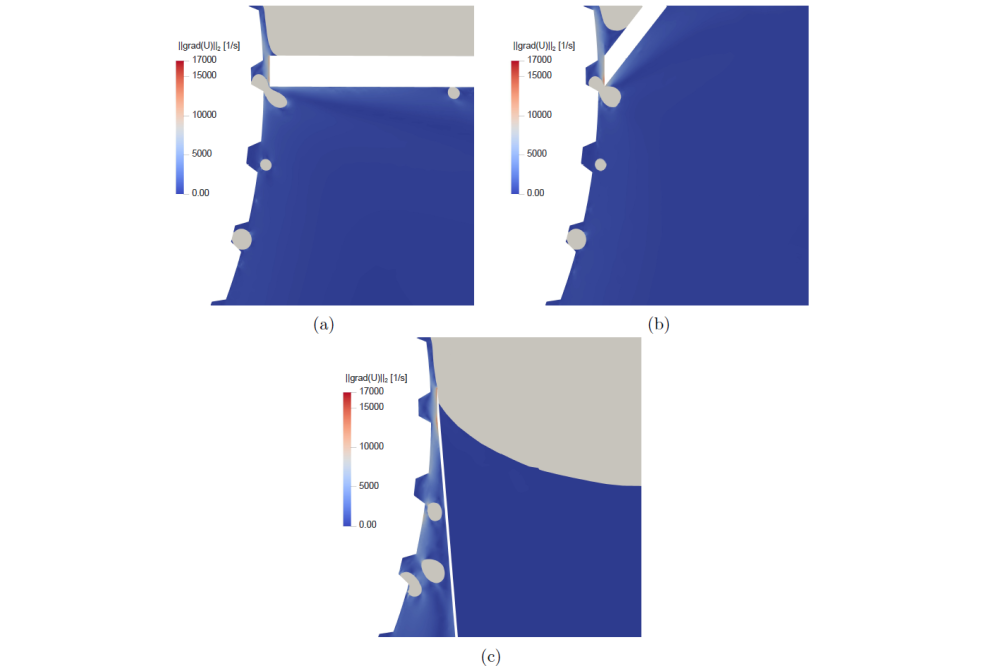Numerical Investigation and Optimisation of Doctor Blading in the Gravure Printing Process
Einleitung
Stainless steel doctor blading is a preferred method for predosing inks in industrial mass printing, offering versatility in handling various viscosities. Modern blade materials minimize wear, enabling precise cell filling on large cylinder widths. The doctor blade’s role in gravure, flexographic, and offset lithographic presses is crucial for ink dosing and transfer. Corrections to printed image quality hinge on blading parameters, particularly the angle. Efficient air removal, facilitated by a well-calibrated doctor blade angle, is vital for preventing print defects. Focusing on effective air removal improves overall print quality and production efficiency in rotogravure processes. A well-optimized doctor blade angle is indispensable for successful, cost-efficient, high-quality rotogravure printing. Utilizing computational fluid dynamics simulations provides valuable insights into how air becomes trapped within engraved cells in the first place and gets subsequently removed at various doctor blade angles. This study introduces a concept that combines simulation results with numerical optimization techniques, aiding in the identification of the optimal doctor blade angle for specific printing conditions.
Methoden
To optimize the doctor blade angle for efficient air evacuation from the gravure cells, a systematic approach involving multiple simulations is undertaken. This iterative process involves running simulations of the doctor blading procedure with varying blade angles while concurrently assessing the residual air in the gravure cells, aiming for minimization. The optimization procedure is divided into three distinct subtasks. Firstly, automated geometry and mesh generation for the gravure print geometry, incorporating varying blade angles, were achieved using Salome coupled with a Python script for automation. The second subtask involved simulating the ink acquisition and doctor blading process, utilizing OpenFOAM’s volume of fluid solver interDyMFoam, capable of handling moving meshes necessary to account for the rotating motion of the gravure cylinder. Lastly, the third subtask encompassed the evaluation of residual air within the gravure cells post-doctor blading, coupled with steering the optimization process. Dakota, specialized software for optimization and uncertainty quantification, was employed for managing this critical subtask.
Ergebnisse
Through numerous optimization runs within fixed doctor blade angle bounds (αL = 5° to αU = 175°), with varying initial angles, a significant observation emerged. The computed optimal angle (αopt) was notably dependent on the chosen initial value due to the inherent noise in the objective function, characterized by numerous local minima and maxima. The intricate features complicated the Gauss-Newton optimization process, emphasizing the complex nature of underlying fluid dynamics. Despite these challenges, a multi-start optimization approach was employed to mitigate local optima’s influence, revealing a consistent global trend. Smaller doctor blade angles consistently led to more efficient entrapped air removal, aligning with the lower bound of αopt = αL = 5°. This trend results from heightened shear forces generated by smaller angles, expelling air bubbles before reaching the blade tip. The evaluation of the velocity gradient field further support these findings, highlighting the dynamics of bubble removal and underlining the trade-offs between effective removal and lingering in the wedge between the cylinder and the doctor blade.
Diskussion
This optimization study provides valuable insights into optimizing doctor blade angles for efficient air removal in gravure cells. The consistent global trend reveals increased air removal efficiency with smaller angles, highlighting the significance of shear forces in this process. Despite the challenges posed by a noisy optimization landscape, the study effectively showcases the potential synergy between numerical simulations, optimization techniques, and domain knowledge to enhance gravure printing capabilities. The intricate interplay between fluid dynamics and optimization challenges is emphasized, underscoring their significance in real-world engineering applications. Looking ahead, promising avenues for exploration and development emerge. The reduction of gravure cell sizes and narrowing the gap width between the doctor blade and the cylinder is identified as essential for modeling real-world behavior. However, this requires a careful balance due to the associated demand for computational resources. An alternative approach involves utilizing an overset mesh framework to reduce the gap width. The natural progression includes expanding the study into three-dimensional simulations, offering a more comprehensive understanding of fluid behavior and enabling exploration of additional optimization parameters and complexities.





